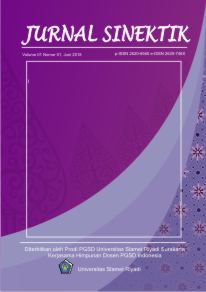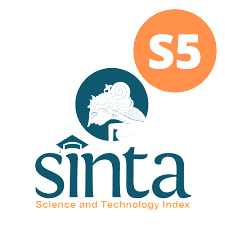ANALISIS KEMAMPUAN BERPIKIR KREATIF PESERTA DIDIK KELAS V DALAM MENYELESAIKAN SOAL ETNOMATEMATIKA DI MIM GIRIMARGO
DOI:
https://doi.org/10.33061/js.v4i2.6657Keywords:
creative thingking, etnhomathematicAbstract
The focus of this research is to 1) analyze learners' creative thinking skills and 2) identify the variables that restrict learners' capacity to think creatively in addressing ethnomathematics issues at MIM. Sragen, Girimargo The research method employed is qualitative research with analytical study methodologies. This study's participants were class V students, instructors, and parents. Interviews, observations, and documentation were utilized to collect data. A qualitative descriptive interaction model is used in this study's data analysis approach. The findings of this study are as follows: (1) learners with good mathematical skills and the capacity to think creatively at level 3 are creative, whereas learners with low mathematical skills and the ability to think creatively at level 1 are less creative. (2) Communication, laziness, and a lack of desire are variables that impede learners' capacity to think creatively while addressing ethnomathematics issues. Lack of mental freedom, as well as a lack of material resources.
References
Agustina H, P., & Edy, S. (2017). Creative Thingking (Berpikir Kreatif) dalam Pembelejaran Matematika. ABA Journal, 102 (4).
Akhiruddin, Sujarwo, Haryanto, & Nurhikmah. (2019). Belajar Dan Pembelajaran. Gowa: CV. Cahaya Cemerlang.
Dini, R., & Nuryanis. (2017). Analisis Kemampuan Berpikir Kreatif Matematis Siswa SD Dalam Menyelesaikan Open-Ended Problem. Jurnal JPSD, 4(2), 54–62.
Miles, M.B & Huberman A.M. (1984). Analisis Data Kualitatif. Terjemahan oleh Tjetjep Rohendi Rohidi. 1992. Jakarta : Penerbit Universitas Indonesia.
Muhammad, Z. M., Sukma, N., & Ervina. (2018). Belajar Matematika Melalui Batik Jlamprong. Prosiding Seminar Nasional Universitas Pekalongan, 41–48.
Nurjanatin, I., Sugondo, G., & M.H. Manurung, M. (2017). Analisis Kesalahan Peserta Didik Dalam Menyelesaikan Soal Cerita Pada Materi Luas Permukaan Balok Di Kelas VII-F Semester II SMP Negeri 2 Jayapura. Jurnal Ilmiah Matematika Dan Pembelajarannya, 2(1), 22–31.
Rismawati, Huri, S., & Ihwan, Z. (2019). Pengembangan Desain Pembelajaran Matematika Kelas V SD Berbasis Etnomatematika. MUST: Journal Mathematics Educations, Science and Technology, 4(2), 230–250.
Sugiyono. (2018). Metode Penelitian Pendidikan Pendekatan Kuantitatif, Kualitatif dan R&D. Bandung: Alfabeta.
Ulfa, S., & Wiryanto. (2020). Analisis Berfikir Kreatif Peserta Didik Dalam Menyelesaikan Soal Materi Bangun Ruang Ditinjau berdasarkan Kemampuan Matematika Peserta Didik Sekolah Dasar. JPGSD, 8(1), 143–153.
Yayah, H., Elang, W., & Lensi, H. (2019). Analisis Kemampuan Berfikir Kreatif Matematis Siswa Dalam Menyelesaikan Soal Pemecahan Masalah. Indonesian Journal Elementary Eduction, 1(1), 56–65.
Yeyen, F., Yulia, D., & Siti, F. (2016). Analisis Kemampuan Berpikir Kreatif Peserta Didik Dengan Memanfaatkan Lingkungan Pada Mata Pelajaran Ekonomi di SMA Negeri 6 Palembang. Jurnal Profit, 3(1), 121–127.
Downloads
Published
Issue
Section
License
Copyright (c) 2021 Jurnal Sinektik

This work is licensed under a Creative Commons Attribution-NonCommercial 4.0 International License.
Authors who publish this journal agree to the following terms:
- Authors retain copyright and grant the journal right of first publication with the work simultaneously licensed under a Creative Commons Attribution License that allows others to share the work with an acknowledgement of the work's authorship and initial publication in this journal.
- Authors can separately make additional contractual arrangements for non-exclusive distribution published by the journal (e.g., publish it in a book), with an acknowledgement of its initial publication in this journal.
- Authors are allowed and encouraged to send their work via online (e.g., in the institutional repositories or their website) after published by the journal.














